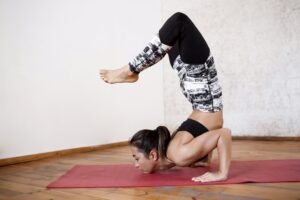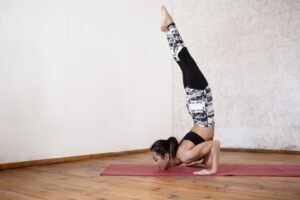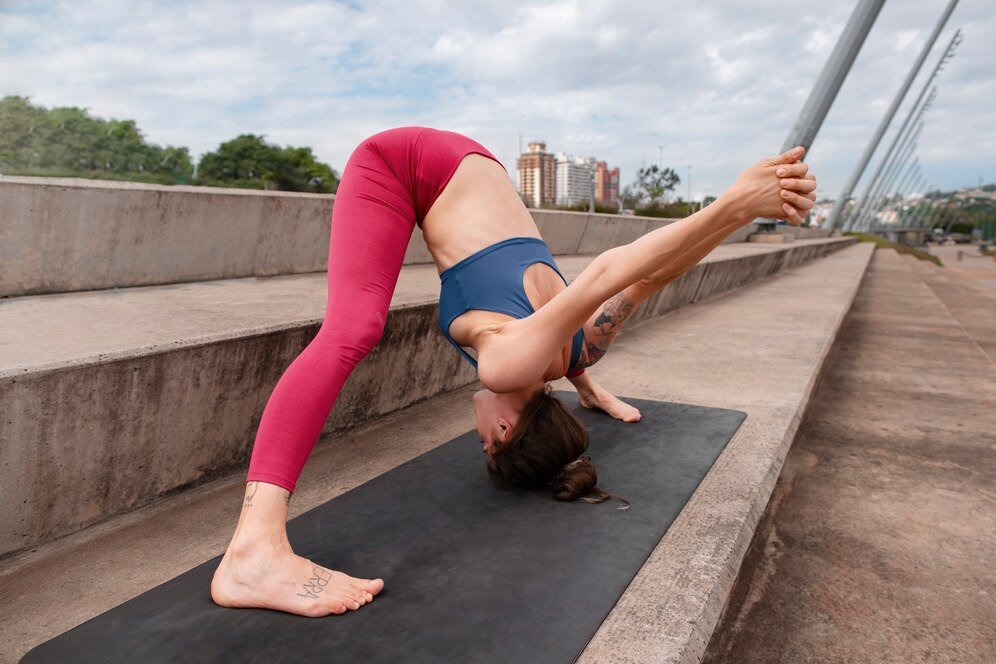Introduction
Many people refer to the yoga headstand as the “king of all yoga poses.” It has many advantages, such as enhanced brain clarity, core strength, and circulation. To assure safety, though, mastering a headstand calls for perseverance, repetition, and the right form. We’ll break down how to perfect the yoga headstand in this guide.
Benefits of the Yoga Headstand
Let’s examine a few advantages of the yoga headstand before getting into the how-to:
- Enhances Blood Circulation: Lying on one’s back increases blood flow to the brain, which can improve mental clarity and focus.
- Strengthens Core Muscles: Headstand balancing works the arms, shoulders, and core muscles.
- Lowers tension: By calming the mind, the headstand can help lower tension and anxiety levels.
- Enhances Stability and Balance: Consistent practice can help you become more conscious of your body and more balanced overall.
Precautions
The yoga headstand is a challenging pose that needs to be done carefully:
- See a Physician: Before attempting a headstand, seek medical advice from a physician if you have high blood pressure, neck or back pain, or any other health concerns.
- Employ a Spotter: To avoid falls, have someone spot you, especially when you’re first starting out.
- Warm Up: Use postures like Downward Dog, Dolphin Pose, and Plank to make sure your body is ready.
Step-by-Step Guide to Achieving a Yoga Headstand
Step 1: Find a Suitable Space
Choose a clear area with enough space around you. Use a yoga mat to provide cushioning for your head and forearms.
Step 2: Start in Child’s Pose
Begin in Child’s Pose (Balasana) to center yourself and prepare mentally for the inversion.
- Kneel on the floor with your big toes touching and sit back on your heels.
- Stretch your arms forward, resting your forehead on the mat.
- Take deep breaths and relax.

Step 3: Move to Dolphin Pose
To activate your shoulders and core, move from Child’s Pose into Dolphin Pose.
- Like in Downward Dog, but with your forearms on the mat, lift your hips and straighten your legs into an inverted V.
- Press your forearms onto the mat and maintain a shoulder-width distance between your elbows.
Step 4: Set Up Your Foundation
For stability, you must use your arms to establish a firm base yoga headstand.
- Make a cup shape with your hands by interlacing your fingers.
- Using your hands to cup your head’s back, place your head’s crown on the mat.
- Make sure the space between your elbows is shoulder-width.
Step 5: Lift Your Hips Yoga Headstand
Elevate your hips toward the ceiling after establishing your foundation.
- While maintaining a straight posture, bring your feet closer to your head.
- To stay stable, use your shoulders and core.
Step 6: Practice Lifting One Leg at a Time
To become acclimated to the weight shift, practice lifting one leg at a time before going completely upside down.
- Elevate one leg while maintaining a grounded foot position.
- While keeping your balance and control, switch legs.
Step 7: Bring Both Legs Up Yoga Headstand
When you feel confident, bring both legs up.
- Bend one knee and draw it into your chest, then lift the other leg.
- Engage your core and use your hips to guide your legs upward.
- Slowly straighten both legs, reaching toward the ceiling.
Step 8: Hold the Pose Yoga Headstand
Once you’re in the headstand, concentrate on your breathing and alignment yoga headstand.
- Maintain an active core and legs.
- As your strength and confidence grow, progressively lengthen the time you spend in this pose. Start with a few breaths.

Coming Down Safely
Carefully reverse these steps to exit the yoga headstand:
- Lower one leg at a time, carefully and steadily.
- Return to Child’s Pose to finish up.
Tips for Success
Practice Often: Mastering the headstand requires regular practice.
Pay Attention to Alignment: Safe practice and injury prevention are ensured by proper alignment.
Use a Wall: Practicing up against a wall might give you more assurance and support.
Pay attention to your body: If you experience any strain or discomfort, ease out of the posture and take a break.
Conclusion
A gratifying pose that can improve your general well-being and yoga practice is the headstand. You too may safely accomplish and reap the benefits of a headstand by practicing frequently and by following these procedures. Always remember to appreciate your progress along the way and have patience with yourself. Cheers to your practice!
